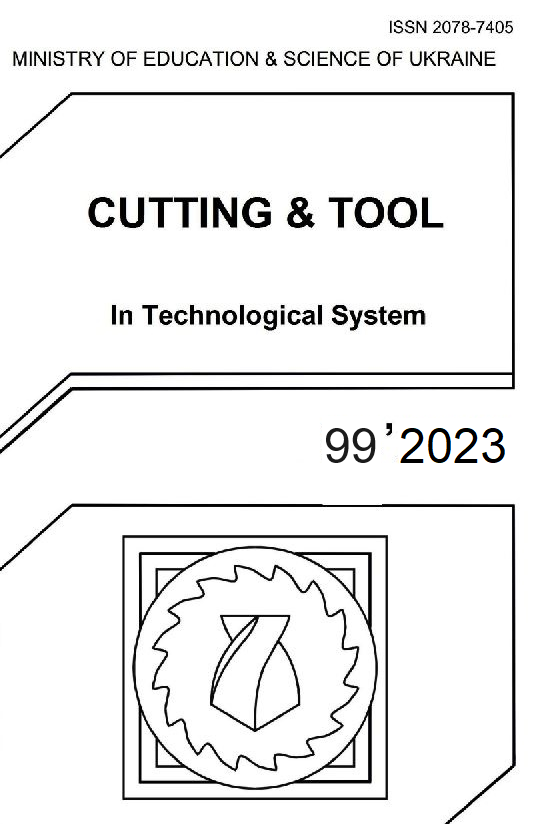ANALYSIS OF THE EFFECT OF VARYING THE CUTTING RATIO ON FORCE COMPONENTS AND SURFACE ROUGHNESS IN FACE MILLING
DOI:
https://doi.org/10.20998/2078-7405.2023.99.01Keywords:
high feed milling, cutting force components, surface roughnessAbstract
Traditional machining processes, such as face milling, still play a very important role in the production of machine parts and are the subject of ongoing research. One important area of research is the investigation of high-feed milling processes. However, due to the increased feed per tooth value fz, it is advisable to reduce the depth of cut (ap) in order to maintain the cutting forces at an appropriate level. In this way, the ratio of these two technological parameters, the so-called cutting ratio, changes and we can move into the range of inverse machining, where ap / fz < 1. In this paper, the consequences of this change is investigated on the surface roughness and the components of the cutting force, and it is discussed how the optimal cutting ratio can be found.
References
Liang S. Y., Hecker R. L., Landers R. G.: Machining Process Monitoring and Control: The State-of-the-Art. Journal of Manufacturing Science and Engineering 2004 126, 2: 297–310 https://doi.org/10.1115/1.1707035.
Kar B. C., Panda A., Kumar R., Sahoo A. K., Mishra R. R.: Research trends in high speed milling of metal alloys: A short review. Materials Today: Proceedings 2020 26: 2657–2662 https://doi.org/10.1016/j.matpr.2020.02.559.
Henz R. O., Campos F., Araujo A. C., Fromentin G.: Cutting Forces in High Feed Milling., presented at the 25 International Conference for Mechanical Engineering, Uberlândia, Brazil, 2019.
Kundrák J., Markopoulos A. P., Makkai T., Nagy A.: Correlation Between Chip Ratio and Specific Forces with Increasing Feed per Tooth and Cutting Speed in Face Milling of Steel. WSEAS Transactions on Environment and Development 2018 14, 1: 338–346
Xu J., Li L., Lin T., Gupta M. K., Chen M.: Machinability analysis in high-speed milling of AlSi7Mg alloys under EMQL conditions: An approach toward sustainable manufacturing. Journal of Manufacturing Processes 2022 81: 1005–1017 https://doi.org/10.1016/j.jmapro.2022.07.010.
Wang Y.-C., Kim D.-W., Katayama H., Hsueh W.-C.: Optimization of machining economics and energy consumption in face milling operations. Int J Adv Manuf Technol 2018 99, 9: 2093–2100 https://doi.org/10.1007/s00170-018-1848-6.
Sztankovics I.: The Effect of the Circular Feed on the Surface Roughness and the Machining Time. Cutting & Tools in Technological System 94: 70–76 https://doi.org/10.20998/2078-7405.2021.94.08.
Varga G., Kundrák J.: Effects of Technological Parameters on Surface Characteristics in Face Milling. Solid State Phenomena 2017 261: 285–292 https://doi.org/10.4028/www.scientific.net/SSP.261.285.
Borysenko D., Karpuschewski B., Welzel F., Kundrák J., Felhő C.: Influence of cutting ratio and tool macro geometry on process characteristics and workpiece conditions in face milling. CIRP Journal of Manufacturing Science and Technology 2019 24: 1–5 https://doi.org/10.1016/j.cirpj.2018.12.003.
Sztankovics I., Kundrák J.: Chip Removal Characteristics with Constant Chip Cross-Sectional Area and Different ap/fz Ratios in Face Milling. 2017
Beňo J., Maňková I., Vrábel M., Karpuschewski B., Emmer T., Schmidt K.: Operation Safety and Performance of Milling Cutters with Shank Style Holders of Tool Inserts. Procedia Engineering 2012 48: 15–23 https://doi.org/10.1016/j.proeng.2012.09.479.
Toledo J. V. R., Arruda E. M., Júnior S. S. C., Diniz A. E., Ferreira J. R.: Performance of wiper geometry carbide tools in face milling of AISI 1045 steel. J Braz. Soc. Mech. Sci. Eng. 2018 40, 10: 478 https://doi.org/10.1007/s40430-018-1400-5.
Fedorovych V. O., Ostroverkh Y. V., Kozakova N. V.: The Methodology of Sharpening of Blade Tools Made of Superhard Materials. Cutting & Tools in Technological System 2019 91: no.91 https://doi.org/10.20998/2078-7405.2019.91.17.
Skoczylas A., Zaleski K.: Studies on the Selected Properties of C45 Steel Elements Surface Layer After Laser Cutting, Finishing Milling and Burnishing. Advances in Science and Technology. Research Journal 2016 10, 32: 118–123 https://doi.org/10.12913/22998624/65127
Downloads
Published
Issue
Section
License
Copyright Notice
Authors who publish with this Collection agree to the following terms:
1. Authors retain copyright and grant the Collection right of first publication with the work simultaneously licensed under a Creative Commons Attribution License that allows others to share the work with an acknowledgement of the work's authorship and initial publication in this Collection.
2. Authors are able to enter into separate, additional contractual arrangements for the non-exclusive distribution of the Collection's published version of the work (e.g., post it to an institutional repository or publish it in a book), with an acknowledgement of its initial publication in this Collection.
3. Authors are permitted and encouraged to post their work online (e.g., in institutional repositories or on their website) prior to and during the submission process, as it can lead to productive exchanges, as well as earlier and greater citation of published work.

